
HOME
INTRO
SYMBOLS
ALMANAC
ECONOMY
GEOGRAPHY
STATE MAPS
PEOPLE
FORUM
NEWS
COOL SCHOOLS
STATE QUIZ
STATE LINKS
BOOK STORE
MARKETPLACE
GUESTBOOK
CONTACT US


Andrew Johnson (1808 - 1875)
In Article II, Section 1 of the Constitution of the United States of America, the following requirements are stipulated for those wishing to hold the office of the President of the United States.
No person except a natural born Citizen, or a Citizen of the United States, at the time of the Adoption of this Constitution, shall be eligible to the Office of President; neither shall any Person be eligible to that Office who shall not have attained to the Age of thirty-five Years, and been fourteen Years a Resident within the United States.
17th President of the United States (1865–1869)
With the Assassination of Lincoln, the Presidency fell upon an old-fashioned southern Jacksonian Democrat of pronounced states' rights views. Although an honest and honorable man, Andrew Johnson was one of the most unfortunate of Presidents. Arrayed against him were the Radical Republicans in Congress, brilliantly led and ruthless in their tactics. Johnson was no match for them.
Born in Raleigh, North Carolina, in 1808, Johnson grew up in poverty. He was apprenticed to a tailor as a boy, but ran away. He opened a tailor shop in Greeneville, Tennessee, married Eliza McCardle, and participated in debates at the local academy.
Entering politics, he became an adept stump speaker, championing the common man and vilifying the plantation aristocracy. As a Member of the House of Representatives and the Senate in the 1840's and '50's, he advocated a homestead bill to provide a free farm for the poor man.
| Andrew Johnson: | |
|---|---|
| Source: University of Virginia: Miller Center of Public Affairs, Andrew Johnson, 18 March 2011 <www.millercenter.virginia.edu>. | |
| 17th President of the United States | |
| Born: | December 29, 1808, Raleigh, North Carolina. |
| Nickname: | None known. |
| Education: | No formal education, apprenticed to tailor. |
| Religion: | No formal affiliation. |
| Marriage: | May 17, 1827, to Eliza McCardle (1810–1876) |
| Children: | Martha (1828–1901), Charles (1830–1863), Mary (1832–1883), Robert (1834–1869), Andrew (1852–1879) |
| Career: | Tailor; Public Official |
| Political Party: | Democrat; Unionist |
| President: | Partial term (4 years) from March 4, 1865. |
| Age at inauguration: | 56 |
| Died: | July 31, 1875, Carter’s Station, Tennessee. |
| Interred: | Greeneville, Tennessee. |
During the secession crisis, Johnson remained in the Senate even when Tennessee seceded, which made him a hero in the North and a traitor in the eyes of most Southerners. In 1862 President Lincoln appointed him Military Governor of Tennessee, and Johnson used the state as a laboratory for reconstruction. In 1864 the Republicans, contending that their National Union Party was for all loyal men, nominated Johnson, a Southerner and a Democrat, for Vice President.

LINKNAME
After Lincoln's death, President Johnson proceeded to reconstruct the former Confederate States while Congress was not in session in 1865. He pardoned all who would take an oath of allegiance, but required leaders and men of wealth to obtain special Presidential pardons.
By the time Congress met in December 1865, most southern states were reconstructed, slavery was being abolished, but "black codes" to regulate the freedmen were beginning to appear.
Radical Republicans in Congress moved vigorously to change Johnson's program. They gained the support of northerners who were dismayed to see Southerners keeping many prewar leaders and imposing many prewar restrictions upon Negroes.
The Radicals' first step was to refuse to seat any Senator or Representative from the old Confederacy. Next they passed measures dealing with the former slaves. Johnson vetoed the legislation. The Radicals mustered enough votes in Congress to pass legislation over his veto--the first time that Congress had overridden a President on an important bill. They passed the Civil Rights Act of 1866, which established Negroes as American citizens and forbade discrimination against them.
A few months later Congress submitted to the states the Fourteenth Amendment, which specified that no state should "deprive any person of life, liberty, or property, without due process of law."
All the former Confederate States except Tennessee refused to ratify the amendment; further, there were two bloody race riots in the South. Speaking in the Middle West, Johnson faced hostile audiences. The Radical Republicans won an overwhelming victory in Congressional elections that fall.
In March 1867, the Radicals effected their own plan of Reconstruction, again placing southern states under military rule. They passed laws placing restrictions upon the President. When Johnson allegedly violated one of these, the Tenure of Office Act, by dismissing Secretary of War Edwin M. Stanton, the House voted eleven articles of impeachment against him. He was tried by the Senate in the spring of 1868 and acquitted by one vote.
In 1875, Tennessee returned Johnson to the Senate. He died a few months later.
Source: The White House: Presidents, Andrew Johnson 18 Mar 2011 <www.whitehouse.gov/about/presidents>.
Presidential $1.00 coin:
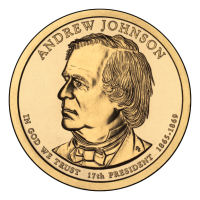
U.S. Mint Image
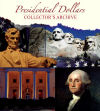
Presidential Dollars
Collector's Archive
Born in Raleigh, North Carolina, in 1808, Andrew Johnson grew up in poverty. He was apprenticed to a tailor as a boy and later opened a tailor shop in Greeneville, Tenn., married Eliza McCardle and participated in debates at the local academy. Entering politics, he became an adept stump speaker, championing the common man and vilifying the plantation aristocracy. As a member of the U.S. House of Representatives and Senate in the 1840s and 1850s, he advocated a homestead bill to provide a free farm for poor men. In 1864, the Republican Party nominated Johnson, a Democrat, for vice president.
After President Abraham Lincoln's death, President Johnson proceeded with a moderate approach to reconstruct the southern states. Radical Republicans in Congress, however, had their own plans and again placed southern states under military rule. They passed laws placing restrictions upon the President. When Johnson allegedly violated the Tenure of Office Act by dismissing Secretary of War Edwin M. Stanton, the House of Representatives voted 11 articles of impeachment against him. He was tried by the Senate in the spring of 1868 and acquitted by one vote. While he was President, the U.S. acquired the Alaska territory and Midway Islands in the Pacific. After leaving the presidency, Johnson went back to Tennessee, remaining politically active. In 1874, Tennessee returned Johnson to the Senate, making him the only former President to have served in the Senate. He died a few months later on July 31, 1875.
Coinage Legislation under Andrew Johnson
- Act of March 3, 1865: Authorized the coinage of three-cent pieces.
- Act of May 16, 1866: Authorized the coinage of five-cent pieces.
United States Mint Directors appointed by Andrew Johnson
- William Millward of Pennsylvania, 1866 – 1867.
- Richard Henry Linderman of Pennsylvania, 1867 - 1869.
Source: The United States Mint, Andrew Johnson Presidential $1 Coin. 19 March 2013 <www.USMint.gov>
Presidential state dollars: Information about design of the Presidential $1 Coins.
Presidential $1 Coins: Release information regarding the Official U.S. Mint Presidential $1 Coins.
Additional Information
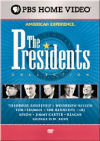
The Presidents
Collection DVD
United States Presidents: List of all United States Presidents from NETSTATE.COM.
Andrew Johnson: America's Story from the America's Library: The Library of Congress.
Vote to Impeach Andrew Johnson May 16, 1868: America's Story from the America's Library: The Library of Congress.
Biography: 17. Andrew Johnson Brief biography from the Public Broadcasting System's American Experience: The Presidents.
Andrew Johnson: Biography from the State Library of North Carolina.
JOHNSON, Andrew, (1808 - 1875): Biographical Guide of the United States Congress.
Andrew Johnson National Historic Site and National Cemetery: This National Park Service site interprets the life and legacy of the 17th President. Andrew Johnson's presidency, 1865-1869, illustrates the United States Constitution at work following President Lincoln's assassination and during attempts to reunify a nation torn by civil war.
Andrew Johnson: A Site to Complement C-SPAN's 20th Anniversary Television Series, American Presidents: Life Portraits.
Andrew Johnson (1808 - 1875) American President: An Online Reference Resource from the Miller Center of Public Affairs, University of Virginia. In-depth information reviewed by prominent scholars on each President and administration.
Presidential Inaugurations: Andrew Johnson Presidential Inaugurations is presented by the Library of Congress, and other governmental departments, in collaboration with the Avalon Project at the Yale Law School. This presentation includes diaries and letters of presidents and of those who witnessed inaugurations, handwritten drafts of inaugural addresses, broadsides, inaugural tickets and programs, prints, photographs, and sheet music.
Andrew Johnson Dead: Obituary by The New York Times.
Andrew Johnson: A Resource Guide: American Memory Historical Collections from The Library of Congress.
The American Presidency Project: The American Presidency Project (americanpresidency.org), was established in 1999 as a collaboration between John T. Woolley and Gerhard Peters at the University of California, Santa Barbara. Our archives contain 103,364 documents related to the study of the Presidency.
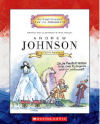
Andrew Johnson
Mike Venezia
Andrew Johnson (Getting to Know the US Presidents), by Mike Venezia. 32 pages. Publisher: Children's Press(CT) (March 1, 2005) Reading level: Grades 3-5.
Mike Venezia mixes facts with humor to introduce the presidents of the United States to students. This unique introduction highlights the life and times of President Andrew Johnson. Venezia uses funny and serious anecdotes to help students understand and realize that presidents are very real people. On each page is either a painting, an engraving, a map, a portrait, or a comical caricature that enhances the text. Captions are included with each that explains the historical paintings and portraits. For reports or pleasure, students will enjoy.
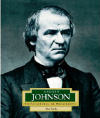
Andrew Johnson
America's 17th President
Don Nardo
Andrew Johnson: America's 17th President, by Don Nardo. 110 pages. Publisher: Children's Press(CT) (March 1, 2004) Reading level: Grades 6-8. PREDESCFROMPUBLISHER.
Learn about the 17th President of the United States, Andrew Johnson. Johnson took office after the assassination of Abraham Lincoln, and was a southerner in a northern-ruled country. Johnson led the country during the turbulent years following the Civil War. Johnson dealt with a range of issues including: southern states rejoining the union; how millions of former slaves should be handled; congressional versus presidential powers; and impeachment.
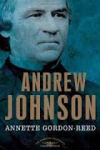
Andrew Johnson
Annette Gordon-Reed
Andrew Johnson: The American Presidents Series: The 17th President, 1865-1869, by Annette Gordon-Reed. 192 pages. Publisher: Times Books; 1st edition (January 18, 2011)
Andrew Johnson never expected to be president. But just six weeks after becoming Abraham Lincoln's vice president, the events at Ford's Theatre thrust him into the nation's highest office. Johnson faced a nearly impossible task—to succeed America's greatest chief executive, to bind the nation's wounds after the Civil War, and to work with a Congress controlled by the so-called Radical Republicans.
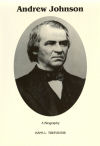
Andrew Johnson
Hans L. Trefousse
Andrew Johnson : A Biography (Signature Series), by Hans L. Trefousse. 463 pages. Publisher: American Political Biography Press (June 1998)
Johnson became President at a moment of supreme triumph and tragedy in American history. Northern victory in the Civil War had preserved the nation from dismemberment and excised the cancer of slavery. But overnight the celebrations turned to mourning when John Wilkes Booth murdered Abraham Lincoln. Without warning or preparations, without Lincoln's prestige, lacking his predecessor's political genius for employing flexible means to achieve principled ends, Johnson faced the daunting tasks of reconstructing a war-torn Union and guiding a slave society in its transition to freedom.
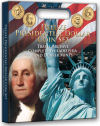
Deluxe Presidential
Dollar Coin
Traveling Archive
Deluxe Presidential Dollar Coin - Traveling Archive , Whitman Publishing (August 7, 2007) Lift off the capsule top, insert the coin, and snap it shut. Now your Presidential dollar is securely stored and attractively displayed - you can even see the coins's edge, which includes the date, mintmark, and inscriptions. Space for both Philadelphia and Denver Mint Coins. Includes Presidential facts printed on the inside flaps. Holds 80 coins - makes a great display and storage unit. (13.375" x 11.5" x 1.0").

Presidential Dollars
Collector's Archive
Presidential Dollars Collector's Archive, Whitman Publishing (August 7, 2007) In December 2005, Congress approved the creation of a new dollar coinage, known as Presidential dollars, and President George W. Bush signed the legislation into law shortly afterward. During each year from 2007 to 2016, four different dollar designs, each bearing the image of a different president, are being released. Living presidents, both current and former, are excluded from the program--thus the roster of presidential honorees currently stands at 37. For these presidents, 38 coins are planned; this is because Grover Cleveland, who to date is the only president to serve multiple nonconsecutive terms, will be represented with two coins. The Presidential dollars are part of the Golden Dollar Program and retain the same golden color as the Sacagawea dollars. The motto IN GOD WE TRUST appears in edge lettering--a first for a U.S. coin, as the motto has never before appeared on the rim. The year of issue is likewise on the rim. Archive Size 11.25" x 10". 40 Openings.
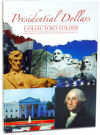
Presidential Folder
Volume I
Presidential Folder 4 Panel - Volume I and Vol II, Whitman Publishing; 1st edition (April 10, 2007) Presidential Folder 4 Panel - Volume I & II Hold P&D Mint Marks. Folder Size 7" x 9,5". Each Volume has 44 Openings - 4 Panels.



